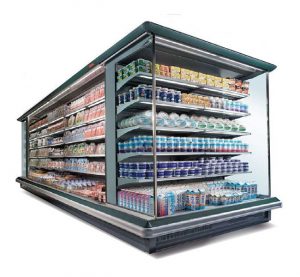A Guide to Supermarket Refrigeration Systems
Step into any supermarket, and you’re immediately enveloped in an invisible, yet intensely functional, world. The constant hum, the crisp, cool air, the dazzling array of fresh produce, succulent meats, and frozen delights – all pristine and preserved. This silent symphony of cooling is orchestrated by sophisticated refrigeration systems, the unsung heroes working tirelessly behind the scenes to ensure our food is safe, fresh, and appealing.
Far more complex than your home refrigerator, supermarket refrigeration is a marvel of engineering, balancing massive cooling demands with energy efficiency, environmental responsibility, and the ever-present need for reliable operation. This guide will take you on a journey into the chilled heart of our grocery stores, exploring the principles, systems, and innovations that keep our food perfectly preserved. At ACL London we undertake all types of Refrigeration unit issues and installs.
The Core Principle: A Dance of States
At its heart, all refrigeration relies on a simple, yet elegant principle: the transfer of heat. Refrigerants, special chemicals designed to change state at specific temperatures and pressures, are the workhorses. The basic vapour-compression cycle, familiar to anyone who’s ever looked up how a fridge works, involves four key components:
- Evaporator: Here, the liquid refrigerant absorbs heat from the food display cases or cold rooms, turning into a low-pressure gas. This is where the cooling happens.
- Compressor: This mechanical pump draws in the low-pressure gas, increasing its pressure and temperature significantly.
- Condenser: The hot, high-pressure gas releases its absorbed heat into the surrounding environment (usually outside the store), cooling down and condensing back into a liquid.
- Expansion Valve (or Metering Device): This component lowers the pressure of the liquid refrigerant, causing it to cool rapidly before it re-enters the evaporator to begin the cycle anew.
This continuous dance of evaporation and condensation, driven by pressure changes, is the essence of keeping things cool.

Types of Supermarket Refrigeration Systems: A Matter of Scale and Strategy
Supermarkets employ various system architectures, each with its own advantages and disadvantages, chosen based on store size, layout, energy goals, and budget.
1. Distributed (Rack) Systems
Historically the most common, distributed systems feature large, centralized banks of compressors (known as “racks”) typically located in a mechanical room. These racks pump refrigerant through extensive piping networks to numerous display cases and cold rooms throughout the store.
Table 1: Pros & Cons of Distributed (Rack) Systems
| Aspect | Pros | Cons |
|---|---|---|
| Control & Efficiency | Centralized control, easier to optimize for varying loads. | Long pipe runs lead to pressure drops and potential energy losses. |
| Maintenance | Easier to service centralized compressors. | Longer pipe runs increase the potential for refrigerant leaks. |
| Heat Rejection | Heat is rejected outside the store, reducing internal heat load. | Requires significant planning for piping infrastructure. |
| Refrigerant Charge | Can have a very large overall refrigerant charge. | Large charge means greater environmental impact if leaks occur. |
| Installation | Complex installation, suitable for new builds or major renovations. | Less flexible for reconfiguring store layouts. |
2. Self-Contained (Plug-in) Systems
In stark contrast, self-contained units are individual display cases or cabinets that house their own complete refrigeration system (compressor, condenser, evaporator, and expansion valve). Just like your fridge at home, you simply plug them in.
Table 2: Pros & Cons of Self-Contained (Plug-in) Systems
| Aspect | Pros | Cons |
|---|---|---|
| Flexibility | Highly flexible for store layout and reconfigurations. | Heat rejected directly into the store, increasing HVAC load. |
| Installation | Easy and rapid installation; simply plug and play. | Higher individual energy consumption (typically) than rack systems. |
| Refrigerant Charge | Small refrigerant charge per unit, lower leak risk impact. | Can generate more noise within the customer shopping area. |
| Maintenance | Easier to isolate and repair one unit without affecting others. | More units to maintain, potentially higher overall service costs. |
| Energy | Can be good for small, specific cooling needs. | Less efficient for large-scale, continuous cooling. |
3. Secondary Loop Systems
These systems offer a clever compromise, aiming to reduce the amount of primary refrigerant used. A primary refrigeration loop (often still a distributed rack system) cools a secondary fluid (like glycol or a CO2 liquid) which is then circulated to the display cases. The secondary fluid, not the primary refrigerant, does the direct cooling of the food.
- Benefit: Significantly reduces the primary refrigerant charge in customer-facing areas, improving safety and environmental impact if leaks occur.
- Drawback: Adds an extra heat transfer step, which can slightly reduce overall energy efficiency.
4. Transcortical CO2 Systems: The Green Evolution
The most significant recent innovation is the widespread adoption of transcortical CO2 (R744) systems. CO2, a natural refrigerant, has an extremely low Global Warming Potential (GWP=1, by definition, essentially no direct climate impact compared to synthetic refrigerants). These systems use CO2 as the primary refrigerant, often in a distributed rack architecture. They operate at much higher pressures than traditional systems, especially in warmer climates where CO2 can enter a “transcritical” state (neither liquid nor gas) in the condenser.
- Benefit: Environmentally superior, non-toxic, non-flammable. Excellent heat recovery potential (using waste heat for store heating or hot water).
- Drawback: High operating pressures require specialized equipment and highly trained technicians. Efficiency can be a challenge in very warm climates, though technological advancements (like ejectors) are rapidly addressing this.
Table 3: Comparison of Key Refrigerant Types
| Refrigerant Type | Global Warming Potential (GWP) | ODP | Common Applications in Supermarkets | Current Status / Trends |
|---|---|---|---|---|
| R404A | 3922 | 0 | Medium & Low-Temp Rack Systems | Being rapidly phased out globally due to extremely high GWP; prohibited in many new systems. |
| R134a | 1430 | 0 | Medium-Temp Rack Systems, Chiller | Under phase-down in many regions due to high GWP; being replaced by lower GWP alternatives or natural refrigerants. |
| R448A / R449A | ~1300 | 0 | Replacement for R404A | Lower GWP blend designed as a “drop-in” alternative for R404A in existing systems and new builds, but still faces future phase-downs. |
| R290 (Propane) | 3 | 0 | Self-Contained Cases, Small Units | Excellent for small, self-contained units due to high efficiency and ultra-low GWP. Flammable, so charge limits apply in public spaces. |
| R744 (CO2) | 1 | 0 | Transcritical Rack Systems, Secondary Loop | The leading natural refrigerant for larger systems, gaining significant market share globally due to ultra-low GWP and efficiency improvements. Requires specialized design and technicians due to high operating pressures. |
Beyond the Cycle: Key Components & Technologies
Supermarket refrigeration is more than just compressors and condensers. A sophisticated ecosystem of components works in harmony:
- Display Cases & Cabinets: These are the customer interface.
- Open Multi-Deck Cases: Attractive visibility but highly energy-intensive due to constant cold air spillage.
- Closed-Door Cases: Significantly more energy-efficient, becoming the standard for chill and frozen.
- Island Freezers & Upright Freezers: Designed for specific product types, often with improved insulation.
- Air Curtains: Invisible barriers of air that help contain cold air within open refrigerated cases, reducing energy loss.
- Defrost Systems: Essential for frozen food cases, these periodically melt ice buildup on evaporators to maintain heat transfer efficiency. Hot gas defrost is often used for energy efficiency.
- Variable Speed Drives (VSDs): Used with compressors and fans, VSDs allow systems to ramp up or down based on cooling demand, dramatically improving energy efficiency compared to all-or-nothing operation.
- Electronic Expansion Valves (EEVs): Offer much more precise control over refrigerant flow than traditional mechanical valves, optimizing system performance and efficiency.
- Energy Management Systems (EMS) / Building Management Systems (BMS): Sophisticated computer networks that monitor and control all aspects of the refrigeration system, optimizing temperatures, defrost cycles, and energy consumption, often integrating with other store systems like lighting and HVAC.
The Imperative: Energy Efficiency & Sustainability
The sheer scale of supermarket refrigeration makes it a massive energy consumer – often accounting for 50-60% of a store’s total electricity bill. This, coupled with growing environmental concerns over high-GWP refrigerants, drives relentless innovation:
- Refrigerant Management: Rigorous leak detection, faster repairs, and transitioning to natural refrigerants (like CO2, propane, ammonia) are paramount.
- Heat Recovery: Waste heat from refrigeration is increasingly captured and reused for space heating, domestic hot water, or even heating adjacent buildings, significantly reducing overall energy consumption.
- Case Design: Moving from open cases to closed-door cases, using LED lighting instead of fluorescent, and improving insulation are standard practices.
- System Optimization: Intelligent controls, VSDs, and EEVs ensure systems operate at peak efficiency under varying load conditions.
- Preventative Maintenance: Regular cleaning, calibration, and early detection of issues prevent efficiency drops and costly breakdowns.
The Future: Smarter, Greener, More Resilient
The supermarket refrigeration landscape is dynamic, shaped by climate legislation, technological advancements, and consumer expectations. We can expect to see:
- Further CO2 System Refinements: Continued improvements in efficiency for transcritical CO2 systems in all climates.
- Hybrid Solutions: Combining different refrigerants and system types to leverage the strengths of each.
- Predictive Maintenance: Leveraging AI and IoT sensors to predict component failures before they occur, minimizing downtime and optimizing maintenance schedules.
- Demand Response: Refrigeration systems integrated with the electrical grid to reduce energy consumption during peak demand periods, contributing to grid stability.
The Silent Symphony Continues
The next time you reach for a perfectly chilled yogurt or a rock-hard bag of frozen peas, take a moment to appreciate the complex, cutting-edge engineering at play. Supermarket refrigeration systems are far more than just “big fridges”; they are a critical pillar of modern commerce, food safety, and environmental stewardship. They are the silent, humming heart of our grocery runs, continuously evolving to meet the demands of a changing world, ensuring our food remains fresh, safe, and accessible for years to come. Please check our dedicated Refrigeration section of our website.


